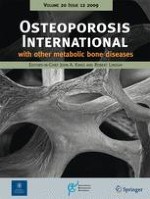01-12-2009 | Original Article
Spinal curvature and postural balance in patients with osteoporosis
Published in: Osteoporosis International | Issue 12/2009
Login to get accessAbstract
Summary
Postural deformity might represent another risk factor for postural instability and falls. Relation between spinal curvatures and postural sway were evaluated. Lumbar (not thoracic) kyphosis and spinal inclination have a statistical correlation with postural sway. Postural deformity with lumber kyphosis may represent as a risk factor for falls.
Introduction
Postural instability has been considered as a risk factor for falls and osteoporotic fractures. Previous studies have demonstrated that several factors display significant relationships with postural instability. Postural deformity might represent another risk factor for postural instability and falls. This study evaluates the influence of spinal curvature on postural instability in patients with osteoporosis.
Methods
Subjects comprised 93 patients with a mean age of 70 years. Angles of thoracic and lumbar kyphosis and spinal inclination that reflected a forward stooped posture were evaluated using a computer-assisted device. Sway and postural instability were evaluated using a computerized stabilometer showing seven parameters. Relationships among parameters of postural deformity and postural balance were analyzed using Pearson’s correlation coefficients.
Results
No significant correlations were observed between any parameters of postural balance and angle of thoracic kyphosis. However, all parameters showed significant positive correlations with angle of lumbar kyphosis (r = 0.251–0.334; p < 0.05–0.001). Moreover, lumbar kyphosis, but not thoracic kyphosis, showed a positive correlation with spinal inclination (r = 0.692, p < 0.001), and all parameters of postural balance showed significant positive correlations with spinal inclination (r = 0.417–0.551, p < 0.001).
Conclusion
Lumbar kyphosis, but not thoracic kyphosis, affecting spinal inclination and postural balance may represent a risk factor for falls.





